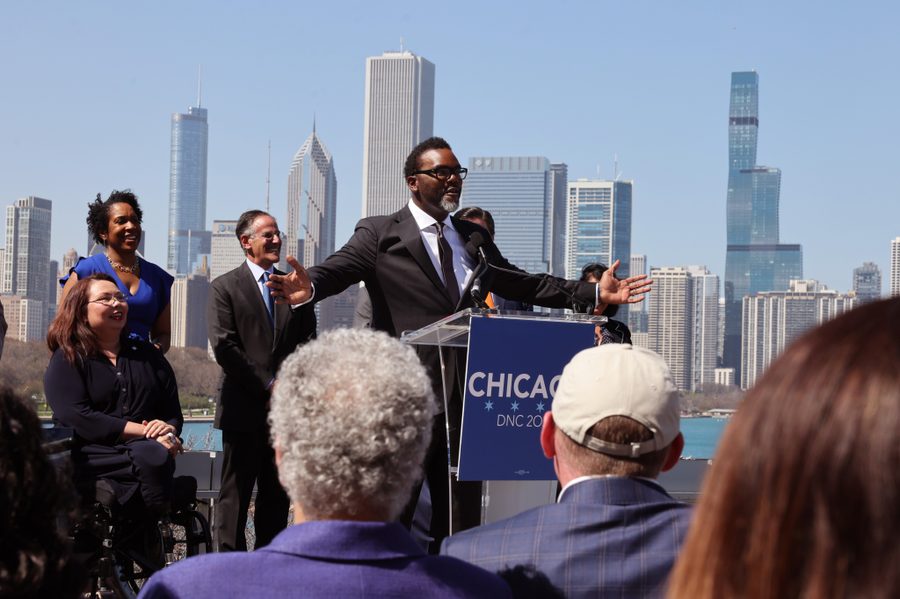As Mayor, Brandon Johnson Should Establish a Public Bank in Chicago
Chicago’s working-class neighborhoods have been exploited by predatory financial institutions and starved of desperately needed investment. Mayor-elect Brandon Johnson could change that by creating a public bank.
Saqib Bhatti

When the cryptocurrency exchange FTX opened its US headquarters in Chicago last May, Mayor Lori Lightfoot heralded it as a win for communities that historically had been denied access to quality banking and financial services. She announced that FTX would donate $1 million to help expand a program to provide formerly incarcerated Chicagoans with a universal basic income. She called the initiative “a mechanism and a tool to bring historically underrepresented and ignored populations into the world of crypto so they can take ownership and control over their own financial destiny.”
Seven months later, the crypto bubble had burst, and FTX had filed bankruptcy without having donated enough money to even get the program off the ground.
Many cryptocurrency and financial technology (“fintech”) firms paint themselves as champions of financial security for Black and brown people who have been excluded and underserved by traditional banks and lenders. In reality, these institutions are another set of unregulated or underregulated corporations trying to make a profit by extracting wealth from poor and working-class communities of color. Rather than putting formerly incarcerated Chicagoans in “control over their own financial destiny,” Mayor Lightfoot instead left them at the mercy of alleged fraudster and FTX founder Sam Bankman-Fried.
Mayor-Elect Brandon Johnson has an opportunity to avoid predatory institutions like crypto and instead put Chicagoans in control of their financial destiny: by establishing a city-owned public bank.
This would allow unbanked and underbanked poor and working-class, Black and brown communities to access high-quality, low-cost financial services, like no-fee bank accounts and low-interest microloans. A public bank could provide financing for Black and brown neighborhoods on Chicago’s South and West Sides by giving access to low-interest loans to establish and grow small businesses. It would enable the city and its sister agencies like the Chicago Public Schools and the Chicago Transit Authority to save millions in fees and interest on cash, investment, and debt management services.
A public bank would be initially capitalized with the deposits of the City of Chicago and its sister agencies. It would also be able to take deposits from other customers, including individual consumers, corporations, and even other local governments and agencies in Illinois. A public bank would have an explicit public interest mission, and its primary goal could be to boost economic development in historically underinvested communities in Chicago.
Because a public bank would generate a profit, it could use that money to increase investments in affordable housing, economic development, and green infrastructure on Chicago’s South and West Sides. During difficult economic times, a public bank could even issue a dividend to its lone shareholder, the City of Chicago, and help fill unforeseen budget gaps.
Racist banking is deeply etched into the history of Chicago’s deeply segregated neighborhoods. Whether it was robbing Black families of the benefits of homeownership by refusing to make mortgage loans in redlined Black neighborhoods or targeting Black and Latine families with predatory subprime mortgages that resulted in a mass wave of foreclosures, banks and mortgage lenders actively helped drive the racial wealth gap in Chicago.
Furthermore, banks’ refusal to adequately locate branches in poor communities of color has had devastating consequences for the financial health of those communities. Areas in Chicago that are more than half a mile from a bank branch are heavily concentrated on the city’s South and West Sides. Unbanked and underbanked residents of urban banking deserts are often forced to rely on predatory payday lenders and expensive check cashing services to meet their financial needs. This can make it difficult to build household wealth. Nationally, even though Black and Latine households account for only 32 percent of the population of the United States, they make up 64 percent of households without a bank account.
By establishing a public bank and opening branches throughout the city, Mayor-Elect Johnson can start to mitigate the pernicious effects of racist and exploitative banking in Chicago. Unlike Mayor Lightfoot’s failed bet on crypto, Mayor-Elect Johnson can actually put Chicagoans in the driver’s seat of their own financial destiny by giving them access to no-fee checking accounts and affordable credit. Opening branches across the city would also help create good government jobs in neighborhoods starved of economic opportunity. With a public bank, Mayor-Elect Johnson can lay the groundwork for wealth building for working-class, Black and brown households in Chicago.
The benefits of the consumer-facing business of a public bank would be amplified dramatically by the benefits of the municipal-facing business. Chicago’s low credit ratings means taxpayers are hit with high interest rates and fees when the city takes out debt. The city and its sister agencies, like CPS, pay $2.1 billion a year in interest on municipal bonds. Chicago and CPS pay nearly $26 million a year in bond issuance fees to banks.
To manage their debt, Chicago and CPS also have a history of taking out predatory financial deals like toxic swaps and payday loans that end up costing taxpayers hundreds of millions of dollars. This is all money that would be better spent on services like fully funding schools, reopening mental health clinics, and expanding public transit.
A public bank could underwrite and issue municipal bonds for Chicago and its sister agencies. It could be structured to allow access to the Federal Reserve’s lending facilities. This could enable the public bank to charge 0 percent interest on the bonds it underwrites for Chicago and its sister agencies and sell them on the secondary market to the Federal Reserve, saving taxpayers more than $2 billion in interest and fees every year. This is money that can go back into critical neighborhood services.
Furthermore, a public bank could hire in-house investment managers to manage Chicago’s seven pension funds. This would enable the city and its sister agencies to avoid $156 million a year in fees. Because the pension funds would be able to invest that money and earn a return on it, it would grow to nearly $1 billion after five years and nearly $16 billion after 30 years. This can help break the cycle of pension underfunding and ultimately also free up more city money for services.
Traditional banks have failed poor and working-class Black and brown Chicagoans time and again. Mayor Lightfoot’s crypto experiment went bust. These communities cannot wait around for Wall Street to decide we are worth investing in. Mayor-Elect Johnson can help us break free of their stranglehold and chart a new path for building wealth by establishing a public bank.
This story was published in collaboration with Jacobin.
Saqib Bhatti is the Executive Director of the Action Center on Race & The Economy.








